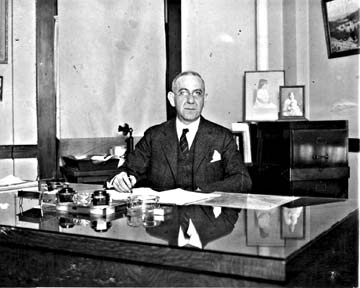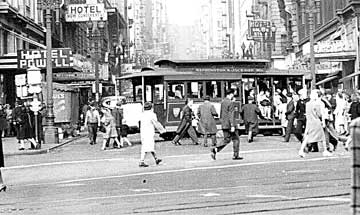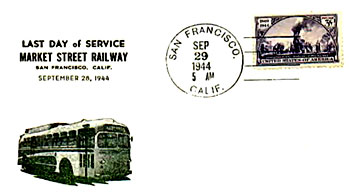| |
SUCCESS,
AND-5 A. M. CHAMPAGNE |
Editor's Notes: Below is the text of the San Francisco News article describing the takeover by the City and County of San Francisco's Municipal Railway of the larger privately owned Market Street Railway, September 29, 1944 at 5:00 a.m. The article appeared that afternoon on page 13 of the News. Both "Muni" and "Muny" as cited in the text. As result of the City purchase Muni operated cable cars for the first time. At Powell and Market passengers from the Powell Cable waved their green transfers happily knowing they could now take any streetcar down Market Street. Despite the oft-repeated statement by Muni conductors that "its 7¢ all over now, they are all 7¢," the independent California Street Cable Railway Co. was still collecting 6¢ fares on its lines.
| Samuel Kahn, the Market Street Railway’s long time president, is pictured at his desk in Stockton as the president of the Western States Gas and Electric (later incorporated into PG&E), prior to coming to San Francisco in November 1925. |  |
The statement in The People’s Railway (on page 134) that after the September 1944 Market Street Railway’s sale that the Market’s long-time president and by the 1940s principal owner Samuel Kahn went to a Byllesby “Chicago Gas Utility” is in error. Samuel Kahn’s daughters (interviewed by the editor January 18, 2004) confirmed that their father retired after leaving the Market Street Railway in 1946 (the corporation had many post-sale business items to settle) Samuel Kahn was offered by A.P. Giannini the presidency of the Bank of America and Robert Dollar Steamship lines also offered their presidency. He declined both preferring retirement. Kahn still owned the Stockton, Terminal & Eastern Railroad and together with clean-up activities of the Market Street Railway he kept busy. His grandson always remembers him as “retired.”
Samuel Kahn died in 1953 at the age of 70 from a heart attack. His wife, who was ten-years his junior, died in 1984 at the age of 91. Before taking over the Market Street Railway Samuel Kahn headed Stockton’s Western States Gas & Electric (later purchased by PG&E). The family (Mr. and Mrs. Kahn, two daughters and nanny) moved to San Francisco’s St. Francis Hotel in November 1925 for a nine month stay before taking up residence in Hillsborough. Walter Rice
 |
WORKING ON THE RAILROAD - Here is Motorman Roger D. Lapham (the mayor to you) taking the first white front streetcar from the Muni barn on Geary Street. (The editor - Mayor Lapham did not realize that soon his political career would be in ruins because of public dissatisfaction with the combined system, notably his plan to substitute busses for Powell Street cable cars. Click on "The Cable Car Lady and the Mayor" in this section.) |
San Francisco News, September 29, 1944
At
5 o'clock this morning the victorious end of the years-long struggle to
consolidate San Francisco's major streetcar systems was celebrated - with
a spontaneous champagne party in Muni Supt. William Scott's office in
the Geary-street headquarters.
A carload of officials, veteran Muni and Market Street Railway workers,
newspapermen and sundry other citizens toasted the new unified lines with
champagne thoughtfully provided by Public Utilities Commission members
(at their own expense).
None of the bottles was broken over trolley prows. The contents were used
for the purpose intended by the vintners.
"San Francisco," said one predawn celebrant, "still knows
how."
| The Muni entered cable car operations as a result of its 1944 purchase of the Market Street Railway that include that company's two remaining cable car lines--Powell & Mason and Washington-Jackson. Here MSRy car No. 525, an 1890 product of the Ferries & Cliff House Railway, is being turned on the famous Powell & Market turntable for another trip to Steiner Street on the Washington-Jackson cable, a few month's before being incorporated into the Muni. Note, on the rear of the No. 525 the famous Market Street Railway shield. |  |
One
of the old-timers there was also there on Dec. 28, 1912, when Mayor James
Ralph Jr. dedicated the new Municipal Railway's first line - from Kearny
Street to Golden Gate Park via Geary. He's William Bendel, now general
superintendent of equipment. He can't recall any champagne on that occasion.
But older still, in years and service, is Fred Wills, who went to work
for the United Railways (sic), MSRy predecessor, in 1888. Then, he recalls
a horse-car driver had to curry and feed the horse - and sweep out the
car - in between runs.
* * *
Muni carmen carried 50,000 pennies in their changemakers and pockets, and tried to remember that when a customer gives you a dime, you give him a nickel and five pennies in return - not two nickels.
* * *
Riding on the back platform of an H line car on Van Ness Avenue two marines discussed the merger. Said one: "Say, we have got to pay 7¢ now. How do you like that?" Said the other: "Hell, I can't afford a nickel."
***
The drive to recruit more workers was opened at once - 500 are needed, Muny officials said - now that the facilities to train them have been acquired by the city. The need is for platform workers, of course, since the offices of the two systems will supply enough clerical help.
* * *
Utilities Mgr. Cahill said right off that the first noticeable improvement in service on the old MSRy lines would come on Ellis Street. He was informed, he said, that Marshall Dill had waited 20 minutes for a car on that line in recent weeks. Mr. Dill, president of the Utilities Commission, is Mr. Cahill's boss.
* * *
One platform man had a standing retort to every complaint: "Mister (or Madam), this is a democracy, and the people voted for this merger, and that's that."
* * *
There are still 350,000 MSRy tokens in circulation, out of a million originally minted, according to Fred Will, MSRy token expert. These may be deposited in the coin boxes of all cars for the next six weeks, or redeemed at MSRy offices, 58 Sutter Street. They are engraved "Market Street Railway" on one side and "Samuel Kahn President" on the other. Their use will save the city about $10,000, it is estimated. But they will be used by the city to save metal.
 |
| A MSRy transfer from the last full day of operations, September 28, 1944. By the time of the purchase by the City, the level of service of the Market Street Railway had reached very low levels. In 1943 the California State Railroad Commission wrote ". . . there is evidence of long-time neglect, of mismanagement, of indifference to urgent public need, and . . . poor service that was by no means caused by the war." The condition of the company has grown progressively worse "and in 1943 the standard of service had reached the lowest point in the company's history." |
Despite the oft-repeated statement by Muni conductors that "its 7¢ all over now, they are all 7¢," the California Street Cable Railway Co. was still collecting 6¢ fares. In answer to the query about issuing the transfer on other lines, the conductor said politely, "No, that doesn't go into effect until about the 15th. They have to arrange about transfers. It all takes time."
* * *
From the conductor on the Muni car traveling abreast on the outside track came a joking "Hey, you're on the wrong track."
* * *
In the window of all Muni cars a red and white sign, visible form inside and outside, asked, "Please have ready 1 nickel, 2 pennies, equal 7¢. Change-making slows down passenger loading. If you'll help us we'll get you there sooner."
* * *
Miss Ruth Phillips, of 4214 Fulton Street, had the painful distinction of being the first citizen to make a claim for personal injuries against the consolidated railways. She was on her customary way to work on a No. 5 car, and got her fingers badly pinched when the door slammed shut. Donald Mazzoni, head of claims department, told her to have her hurts treated by her own physician, and send the city the bill.
* * *
In the gray hours of early morning motorists pausing at the intersect of Masonic Avenue and Geary must have reflected that business was going to be good on the unified lines. Standing there was a No. 31 MSRy car - the newest one the old private line has, only 15 years old - full of people. But, the scene was deceptive. The people were officials and celebrants, the "motorman" was Mayor Lapham, and nickels, pennies or tokens tinkled the conductor's box.
* * *
There's a new counting room at the Geary Street office of the new unified system. In the old days, two clerks were all that were needed count the coins and roll them in paper. The addition of the MSRy lines' business has upped the staff to nine. Every morning they count $50,000, only $14,000 of which will be in paper money. The pennies, nickels, dimes, quarters, and half-dollars (and occasional silver dollars) will be put in sacks in sums ranging from $50 to $1000, depending on the coin sacked. Then guards will take the sacks to the Federal Reserve Bank, or to the city treasury. The new counting room, with slotted counter for money laden conductors, was Installed by George Quinn, senior accountant for Muni.
***
Then there was the former MSRy conductor who had to chase his own car when he dove overboard in pursuit of a wayward penny.
* * *
Police Traffic Capt. Charles Skelly reported that the streetcar situation was proceeding all right with his office with no complaints of disruption of service or accidents. He said he was very anxious to change service at the corner of Stockton and Ellis Streets where the "F" comes in. Conditions there were very bad, he said. The only answer, he said, would be to put the line over Market Street and down to the Southern Pacific Depot.
* * *
Among the Municipal employees working today were 11 men who were on the staff when the first car was run in 1912. These men were known as the Durable Dozen until John Phelan, motorman, died last year. Remaining are Tom Cox, L. G. Marshall, and Louis Litzius, division superintendents; Hugh Duffy, Henry Hauser and John Daly, inspectors; Mark Morehart, George Banker and William Craig conductors; W. C. Bendel, general superintendent of equipment and overhead lines, and Eugene Clisbee, general superintendent of transportation.
* * *
Morton Stern, Muni storekeeper, proudly displayed an empty champagne bottle, on which Mayor Roger Lapham had written: " 5 a. m. September 29, 1944, Let's Go! Roger D. Lapham.
* * *
A group of the inebriated tried to jump the gun at 3 a. m., insisting they had to pay 7¢ for their rides. The conductor was unable to convince them the fare did not go up until 5 o'clock, and one was still arguing when he stepped backward and the car went on without him.
 |
"Last Day of Service" cover of the Market Street Railway, September 28, 1944. Note the cover was canceled at exactly 5 a.m. September 29, 1944, when the MSRy ceased to exist. Surprising the vehicle shown was a bus designed for suburban charter since most of the Market's riders rode on streetcars. |
The universal transfers made some trolley riders quite smug. On the Powell Street cable line terminal passengers would disembark, wave their green transfers happily and make a great show of deciding which car they would ride down Market Street.
* * *
Conductors all over the city reported that almost to a child, school-bound boys and girls had forgotten their MSRy school tickets were no good today. Most had money with them, but one conductor said, "If they didn't, we took 'em to school anyway."
* * *
For the past two weeks the MSRy has advertised that school children's tickets not good on the Muny may be redeemed at car barns, Municipal will sell new tickets for the same price, 16 rides for 50¢.
| To
the Library Home Page |
|
| Back
to the Museum's Home Page |
|